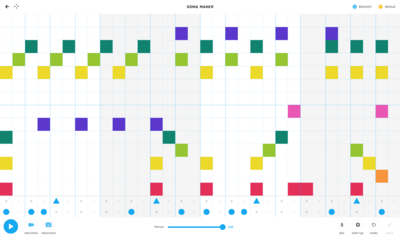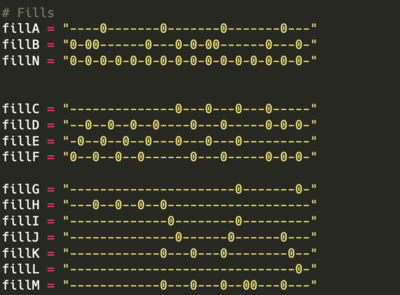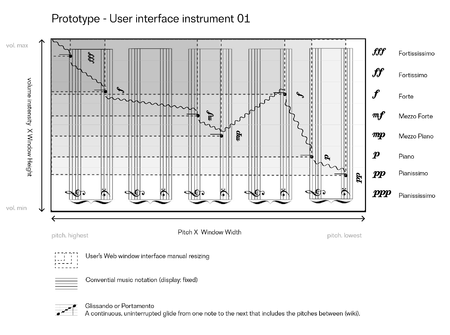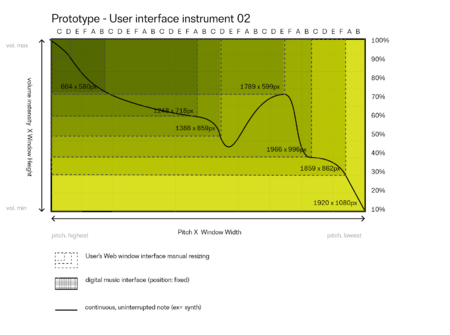SPECIAL ISSUE 15 MARTIN DAILY BOARD: Difference between revisions
| Line 449: | Line 449: | ||
As a side note, not only electronic instruments can play a continuous sound, the bagpipes for example play continuously a "bourdon" simutaneously to the melody, by constantly filling in and spreading out air from the bag. | As a side note, not only electronic instruments can play a continuous sound, the bagpipes for example play continuously a "bourdon" simutaneously to the melody, by constantly filling in and spreading out air from the bag. | ||
<br><br> | <br><br> | ||
[[File:Martinfoucaut responsiveintrument-02.png| | [[File:Martinfoucaut responsiveintrument-02.png|450px|thumb|left|First shema of a incoming prototype attemting to corellate sound pitch and release with window heihgt and weight. This shema is base on conventional musical notation before being translated into a second more analog musical notation.]] | ||
[[File:Responsive instument Sketch-02.png|450px|thumb|right|In this second sketch, I make a step from analog to a more digital musical interface.]] | |||
<br><br><br><br><br><br><br><br><br><br><br><br><br><br><br><br> | |||
<br><br><br><br><br><br><br><br><br><br> | |||
===Links=== | ===Links=== | ||
Revision as of 14:45, 14 May 2021
Overview
To do
- Synth note variation with Sonic Pi
Links
- Radio Implicancies https://pzwiki.wdka.nl/mediadesign/Category:Implicancies
- Radio Implicancies Conference Room https://conf.domainepublic.net/radioimplicancies
- Implicanties Ressources https://pzwiki.wdka.nl/mediadesign/Implicancies_Resources
- Implicancies Guests + contributors https://pzwiki.wdka.nl/mediadesign/Implicancies_Guests_%2B_contributors#Steve_Rushton
- Aesthetic Porgramming https://aesthetic-programming.net/
- Difraction vs Reflection https://possiblebodies.constantvzw.org/files/implicancies/reflection-diffraction.pdf
- Music with Python here https://wiki.python.org/moin/PythonInMusic (note: install github)
Hotlines
- https://hotline.xpub.nl/grs2 Steve
- https://conf.domainepublic.net/radioimplicancies Femke
- https://hotline.xpub.nl/prototyping Manetta and Michael
Pads
- Week 1 Introduction https://pad.xpub.nl/p/15.1
- Week 2 Prototyping w/ Manetta https://pad.xpub.nl/p/15.2-prototyping-Monday
- Week 2 w/ Steve https://pad.xpub.nl/p/Mythodologies19-4-21
- Week 2 w/ Michael https://pad.xpub.nl/p/2021-04-21-prototyping
- Week 3 https://pad.xpub.nl/p/15.3
- Week 3 w/Michael https://pad.xpub.nl/p/mythodologies11-5-21
- Week 3 w/Jacopo and Nami https://pad.xpub.nl/p/15-group5
Keywords
- Implicancies vocabulary https://pad.constantvzw.org/p/implicanties
- Situated knowledges (Donna Haraway)
- Worlding (Haraway:
_ making of worlds. language, science, technology : these forces produce worlds. world doesn't exist w/o language, language is an active part of the world
- The poetic of relations (Eduard Glissant)
- Entanglement (Karen Barad)
_ entanglement assumes that we have different things that are being knotted together _ state of being knotted together Denise Ferreira Da Silva: introduces "implicancies" things be co-response-able for each other starting point is particles
- Response-ability (Barad + Haraway)
- Implicancies (Denise Ferreira Da Silva)
_ The term "implicancies" brings together: entanglement, response-ability & relations. That is why this SI is called Radio Implicancies
- Techno-epistomologies:
_ Technological knowledge systems [metadata etc how algorithms produce data]
- Techno-ontology: How social media puts a filter on the world. We know a lot about bodies through scanning technologie. In line with that: algorithms are part of the world, while structuring the world. So when it is claimed to work on "fair AI" or "fair algorithms", algorithms are placed outside the worlding forces.
_ Donna Haraway's frames of references: biology, US based, 75 year old
https://www.youtube.com/watch?v=J2DcAf16zeI
_ 2nd person that is important in thinking through relations: Eduart Glissant in French context.
Ressources
From https://pzwiki.wdka.nl/mediadesign/Implicancies_Resources
Watching / listening
- Ron Morrison (2018), Decoding space: Liquid infrastructures https://vimeo.com/showcase/5551892/video/306993793 + https://medium.com/digital-earth/when-the-history-repeats-itself-lithium-extraction-in-d-r-congo-b372090c4a5c
- Aimee Bahng (2017), Plasmodial Improprieties: Octavia E. Butler, Slime Molds, and Imagining a Femi-Queer Commons https://soundcloud.com/thehuntington/plasmodial-improprieties
- Martine Syms (2013), The Mundane Afrofuturist Manifesto https://www.kcet.org/shows/artbound/episodes/the-mundane-afrofuturist-manifesto
- Ursula Leguin (1985), She Unnames Them http://ursulakleguinarchive.com/MP3s/BuffaloGals.html
- Edouard Glissant (Manthia Diawara, 2010) One World in Relation https://www.youtube.com/watch?v=aTNVe_BAELY
- Denise Fereira Da Silva, Arjuna Neuman (2019) Four waters: deep implicancy https://hub.xpub.nl/sandboxradio/ingredients/4%20WATERS%20-%20DEEP%20IMPLICANCY.mp4
- Four Rooms – Denise Ferreira Da Silva (2020), on the Logics of Exclusion and Obliteration https://video.constantvzw.org/Four_rooms/Four%20Rooms,%20Denise%20Ferreira%20Da%20Silva,%20on%20the%20Logics%20of%20Exclusion%20and%20Oblitera...-152937289377315.mp4
- Natalie Jeremijenko + Kate Rich Track 12: The mutual synchronisation of coupled oscillators (This was one track from a CD released as an "insert" to Mute Magazine Vol 1, No. 21, September 2001). The other tracks are available as well. In the recording, Jeremijenko speaks; the audio production/remix was done by Rich. They worked together as the Bureau of Inverse Technology.
Reading
- Romi Ron Morrison (2019), Gaps between the digits. On the fleshy unknowns of the HUMAN https://benjamins.com/catalog/idj.25.1.05mor
- Oulimata Gueye (2019), No Congo, no technologies https://medium.com/digital-earth/no-congo-no-technologies-163ea2caec0a
- Martine Syms (2013), The Mundane Afrofuturist Manifesto http://thirdrailquarterly.org/martine-syms-the-mundane-afrofuturist-manifesto/
- Ramon Amaro (2019), Artificial intelligence: Warped, colorful forms and their unclear geometries https://research.gold.ac.uk/27052/1/SoU_AI%2C%20warped%2C%20colorful%20forms....pdf
- Sylvia Wynter (2015), On Being Human as Praxis -- interview with Katherine Mckittrick
- Donna Haraway (2019), A Giant Bumptious Litter: Donna Haraway on Truth, Technology, and Resisting Extinction https://logicmag.io/nature/a-giant-bumptious-litter/?fbclid=IwAR13RpmuwM17aSvo6V-G5EDWF8MpxKunBf-1KuTfExrDsfCK1BHFvCWNv3
- Denise Fereira Da Silva (2016), 'On difference without separability'
- Katherine Mckittrick, Mathematics Black Life
- Zach Blas & Micha Carde (2015), Imaginary computational systems: queer technologies and transreal aesthetics
- Noah Tsika (2016), CompuQueer: Protocological Constraints, Algorithmic Streamlining, and the Search for Queer Methods Online
- Anaïs Nony (2017), Technology of Neo-Colonial Epistemes
- Wendy Hui Kyong Chun (2009), Race and/as Technology; or, How to Do Things to Race
- Syed Mustafa Ali (2016), A brief introduction to decolonial computing
- Michael Murtaugh, Eventual consistency https://diversions.constantvzw.org/wiki/index.php?title=Eventual_Consistency
- Saidiya Hartman, The Plot of Her Undoing
- Alexis Pauline Gumbs and Julia Roxanne Wallace, Black Feminist Calculus Meets Nothing to Prove: A Mobile Homecoming Project Ritual toward the Postdigital
Sketch a musical composition
- Each of the 2 system login sounds slowed down as a starter
Legend Radio with Louisa
Louisa and I created a musical dialogue between Microsoft and Mac operating sound systems. In order to create this soundtrack, we first used Musiclab, a Google song maker allowing to make simple songs with visual patterns. In a second step, we tryed to remake our song with Earsketch, a sound editor working with Python language. By refering to Musicalab visual pattern, we could quiet easily understand how to reconstruct our track in Python. Some screenshots bellow will eventually even show so visual links between the two things!
# python code
# script_name:
#
# author:
# description:
#
from earsketch import *
init()
setTempo(115)
# Add Sounds
fitMedia(MARTINFOUCAUT_STARTUP_CUSTOM , 15, 1, 3)
fitMedia(MARTINFOUCAUT_START_UP_WINDOWS2, 16, 1.5, 4)
fitMedia(MARTINFOUCAUT_STARTUP20, 15, 19, 26)
fitMedia(MARTINFOUCAUT_EVERY_WINDOWS_STARTUP_SHUTDOWN_SOUND_TRIM, 16, 19, 20)
#fitMedia(MARTINFOUCAUT_LOOPE, 5, 20, 30)
#fitMedia(MARTINFOUCAUT_LOOPF, 6, 25, 35)
#fitMedia(MARTINFOUCAUT_LOOPG, 7, 30, 40)
#fitMedia(MARTINFOUCAUT_LOOPH, 8, 35, 45)
#fitMedia(YG_RNB_TAMBOURINE_1, 10, 1, 5)
#fitMedia(YG_FUNK_CONGAS_3, 11, 1, 5)
#fitMedia(YG_FUNK_HIHAT_2, 12, 5, 9)
#fitMedia(RD_POP_TB303LEAD_3, 13, 5, 9)
# Effects fade in
#setEffect(1, VOLUME,GAIN, -20, 5, 1, 10)
# Fills
fillA = "----0-------0-------0-------0---"
fillB = "0-00------0---0-0-00------0---0-"
fillN = "0-0-0-0-0-0-0-0-0-0-0-0-0-0-0-0-"
fillC = "--------------0---0---0---0-----"
fillD = "--0--0--0--0----0---0-----0-0-0-"
fillE = "-0--0--0--0---0---0---0---------"
fillF = "0--0--0--0------0---0-----0-0-0-"
fillG = "----------------------0-------0-"
fillH = "---0--0--0--0-------------------"
fillI = "-------------0--------0---------"
fillJ = "--------------0------0------0---"
fillK = "------------0---0---0--------0--"
fillL = "------------------------------0-"
fillM = "------------0---0---0--00---0---"
makeBeat(MARTINFOUCAUT_WINDOWS_RECYCLE2, 12 , 3, fillA)
makeBeat(MARTINFOUCAUT_BASSO, 13, 3, fillB)
makeBeat(MARTINFOUCAUT_SPEECH_MISRECOGNITION, 14, 2, fillN)
makeBeat(MARTINFOUCAUT_SPEECH_MISRECOGNITION, 14, 4, fillN)
makeBeat(MARTINFOUCAUT_SPEECH_MISRECOGNITION, 14, 6, fillN)
makeBeat(MARTINFOUCAUT_SPEECH_MISRECOGNITION, 14, 8, fillN)
makeBeat(MARTINFOUCAUT_SPEECH_MISRECOGNITION, 14, 10, fillN)
makeBeat(MARTINFOUCAUT_SPEECH_MISRECOGNITION, 14, 12, fillN)
makeBeat(MARTINFOUCAUT_SPEECH_MISRECOGNITION, 14, 14, fillN)
makeBeat(MARTINFOUCAUT_SPEECH_MISRECOGNITION, 14, 16, fillN)
makeBeat(MARTINFOUCAUT_SPEECH_MISRECOGNITION, 14, 18, fillN)
makeBeat(MARTINFOUCAUT_WINDOWS_RECYCLE2, 12 , 4, fillA)
makeBeat(MARTINFOUCAUT_BASSO, 13, 4, fillB)
makeBeat(MARTINFOUCAUT_WINDOWS_RECYCLE2, 12 , 6, fillA)
makeBeat(MARTINFOUCAUT_BASSO, 13, 6, fillB)
makeBeat(MARTINFOUCAUT_WINDOWS_RECYCLE2, 12 , 8, fillA)
makeBeat(MARTINFOUCAUT_BASSO, 13, 8, fillB)
makeBeat(MARTINFOUCAUT_WINDOWS_RECYCLE2, 12 , 10, fillA)
makeBeat(MARTINFOUCAUT_BASSO, 13, 10, fillB)
makeBeat(MARTINFOUCAUT_WINDOWS_RECYCLE2, 12 , 12, fillA)
makeBeat(MARTINFOUCAUT_BASSO, 13, 12, fillB)
makeBeat(MARTINFOUCAUT_WINDOWS_RECYCLE2, 12 , 14, fillA)
makeBeat(MARTINFOUCAUT_BASSO, 13, 14, fillB)
makeBeat(MARTINFOUCAUT_WINDOWS_RECYCLE2, 12 , 16, fillA)
makeBeat(MARTINFOUCAUT_BASSO, 13, 16, fillB)
makeBeat(MARTINFOUCAUT_WINDOWS_DING4, 1, 6, fillC)
makeBeat(MARTINFOUCAUT_WINDOWS_DING3, 2, 6, fillD)
makeBeat(MARTINFOUCAUT_WINDOWS_DING2, 3, 6, fillE)
makeBeat(MARTINFOUCAUT_WINDOWS_DING1, 4, 6, fillF)
makeBeat(MARTINFOUCAUT_WINDOWS_DING4, 1, 8, fillC)
makeBeat(MARTINFOUCAUT_WINDOWS_DING3, 2, 8, fillD)
makeBeat(MARTINFOUCAUT_WINDOWS_DING2, 3, 8, fillE)
makeBeat(MARTINFOUCAUT_WINDOWS_DING1, 4, 8, fillF)
makeBeat(MARTINFOUCAUT_WINDOWS_DING4, 1, 12, fillC)
makeBeat(MARTINFOUCAUT_WINDOWS_DING3, 2, 12, fillD)
makeBeat(MARTINFOUCAUT_WINDOWS_DING2, 3, 12, fillE)
makeBeat(MARTINFOUCAUT_WINDOWS_DING1, 4, 12, fillF)
makeBeat(MARTINFOUCAUT_WINDOWS_DING4, 1, 16, fillC)
makeBeat(MARTINFOUCAUT_WINDOWS_DING3, 2, 16, fillD)
makeBeat(MARTINFOUCAUT_WINDOWS_DING2, 3, 16, fillE)
makeBeat(MARTINFOUCAUT_WINDOWS_DING1, 4, 16, fillF)
makeBeat(MARTINFOUCAUT_GLASS5, 5, 10, fillG)
makeBeat(MARTINFOUCAUT_GLASS, 6, 10, fillH)
makeBeat(MARTINFOUCAUT_GLASS2, 7, 10, fillI)
makeBeat(MARTINFOUCAUT_GLASS3, 8, 10, fillJ)
makeBeat(MARTINFOUCAUT_GLASS4, 9, 10, fillK)
makeBeat(MARTINFOUCAUT_GLASS7, 10, 10, fillL)
makeBeat(MARTINFOUCAUT_GLASS6, 11, 10, fillM)
makeBeat(MARTINFOUCAUT_GLASS5, 5, 12, fillG)
makeBeat(MARTINFOUCAUT_GLASS, 6, 12, fillH)
makeBeat(MARTINFOUCAUT_GLASS2, 7, 12, fillI)
makeBeat(MARTINFOUCAUT_GLASS3, 8, 12, fillJ)
makeBeat(MARTINFOUCAUT_GLASS4, 9, 12, fillK)
makeBeat(MARTINFOUCAUT_GLASS7, 10, 12, fillL)
makeBeat(MARTINFOUCAUT_GLASS6, 11, 12, fillM)
makeBeat(MARTINFOUCAUT_GLASS5, 5, 14, fillG)
makeBeat(MARTINFOUCAUT_GLASS, 6, 14, fillH)
makeBeat(MARTINFOUCAUT_GLASS2, 7, 14, fillI)
makeBeat(MARTINFOUCAUT_GLASS3, 8, 14, fillJ)
makeBeat(MARTINFOUCAUT_GLASS4, 9, 14, fillK)
makeBeat(MARTINFOUCAUT_GLASS7, 10, 14, fillL)
makeBeat(MARTINFOUCAUT_GLASS6, 11, 14, fillM)
finish()
Working with audio interpolations
What did I do?
<br<
Transforming a text into a question/answer text, make it read by a computer
Interpolating the readen text with Who wants to be a billionaire ambiant soundtrack with THX intro and I Feel Love (acapela) from Donna Summer
Original
"Barry Popper’s cruel step-parents make him live in a skip in the driveway of their house. Barry’s stepsister is spoiled and fed cake and ice cream while Barry eats cold spaghetti and licks empty crisp bags. One day a fox delivers a telegram which informs Barry that he has a place in Stinkwort’s Academy. Barry is instructed to go to departure gate 27-and-a-half at Local Airport at such-and-such a time. On arrival he is escorted on to a helicopter by the crew of friendly badgers. On the plane he sits next to fellow Stinkworter, Ginger Boozy. 'Hello, you must be Barry" says Ging...'
Retelling a Story
Question 1
A”Barry Popper’s" cruel step-parents make him live in a skip in the driveway, of?
Answer C
their house.
Question 2
Barry’s stepsister is?
Answer A
spoiled and fed cake and ice cream while
Question 3
Barry eats?
Answer A.
cold spaghetti and licks empty crisp bags.
Question 4
One day a fox delivers a telegram which informs Barry that?
Answer D.
he has a place in Stinkwort’s Academy.
Question 5
Barry is instructed to go to departure gate 27-and-a-half at?
Answer B.
Local Airport at such-and-such a time.
Question 6
On arrival he is escorted on to a helicopter by?
Answer B.
the crew of friendly badgers.
Question 7
On the plane he sits next to?
Answer A.
fellow Stinkworter, Ginger Boozy
https://pad.xpub.nl/p/martinfoucaut_interpolation
Streching audio space/time perception (with sample interpolation, overlap, looping and echoing)
With Sonic Pi and as part of the team with Naami and Jacopro, I am working on time perception, by looping, overlapping and sketching a single track more and more untils it becomes a single constant note.
For what I am doing I could take as a reference this https://www.youtube.com/watch?v=mjnAE5go9dI&list=LLfu-Fy4NjlpiIYJyE447UDA&index=27&t=2743s
"the recordings consist of tape loops that gradually deteriorated each time they passed the tape head, the unexpected result of Basinski's attempt to transfer his earlier recordings to digital format."
Here it is more about a media deterioration than streching the audio space perception, but the process is pretty much the same, so I found relevant to keep this in mind.
Broadcast 3
Personal track description
For my sound piece I worked on a 20 seconds looped sample of the track called Beat Box (Diversion One) from Art of Noise (1984) that I recorded some years ago and more recently transformed to 1 Beat per second. With the help of SonicPI, I am questioning how musical or/and sound echo, overlap and reverberation can affect the listener's mental perception of the space where the music/sounds are being played.
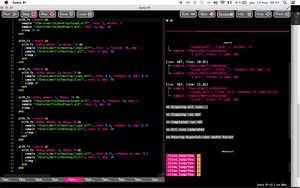
#PLAY THE TRACK ONCE IN NORMAL MODE, NO ECHO, NO REVERB, NO TIME-STRECHING TO GIVE TO THE LISTENER AN IDEA OF WHAT MATERIAL I AM WORKING WITH
with_fx :reverb do
sample "/Users/martin/Desktop/LoopA.aiff", rate: 1, attack: 1
sample "/Users/martin/Desktop/1.aif", rate: 1, amp: 10
sleep 20.05
end
#PLAY THE TRACK ONCE (WITH DECAY AND RELEASE) AND OVERLAP IT WITH THE SAME TRACK PLAYED AT 50% SPEED, DECAY AND RELEASE ONE SECOND AFTER
with_fx :reverb do
with_fx :echo, phase: 1, decay: 16 do
sample "/Users/martin/Desktop/LoopA.aiff", rate: 1, release: 16, amp: 1
sample "/Users/martin/Desktop/1.aif", rate: 1, amp: 10
sleep 1
end
end
with_fx :reverb do
with_fx :echo, phase: 2, decay: 8 do
sample "/Users/martin/Desktop/LoopA.aiff", rate: 0.5, release: 8, amp: 0.75
sample "/Users/martin/Desktop/2.aif", rate: 1, amp: 10
sleep 20
end
end
#PLAY THE TRACK ONCE (WITH DECAY AND RELEASE) AND OVERLAP IT WITH THE SAME TRACK PLAYED AT 50% SPEED, DECAY AND RELEASE ONE SECOND AFTER AND ON AND ON AND ON AND ON (X5)
with_fx :echo, phase: 1, decay: 16 do
sample "/Users/martin/Desktop/LoopA.aiff", rate: 1, release: 16, amp: 1
sample "/Users/martin/Desktop/1.aif", rate: 1, amp: 10
sleep 1
end
with_fx :reverb do
with_fx :echo, phase: 2, decay: 8 do
sample "/Users/martin/Desktop/LoopA.aiff", rate: 0.5, release: 8, amp: 0.75
sample "/Users/martin/Desktop/2.aif", rate: 1, amp: 10
sleep 1
end
end
with_fx :reverb do
with_fx :echo, phase: 4, decay: 4 do
sample "/Users/martin/Desktop/LoopA.aiff", rate: 0.25, release: 4, amp: 0.5
sample "/Users/martin/Desktop/3.aif", rate: 1, amp: 10
sleep 1
end
end
with_fx :reverb do
with_fx :echo, phase: 8, decay: 2 do
sample "/Users/martin/Desktop/LoopA.aiff", rate: 0.125, release: 2, amp: 0.25
sample "/Users/martin/Desktop/4.aif", rate: 1, amp: 10
sleep 1
end
end
with_fx :reverb do
with_fx :echo, phase: 16, decay: 1 do
sample "/Users/martin/Desktop/LoopA.aiff", rate: 0.1, release: 8, amp: 0.1
sample "/Users/martin/Desktop/5.aif", rate: 1, amp: 10
sleep 40
end
end
Nami/Pongie/Martin Description
0916653+1005344+1007629 In a system dominated by measures, demanding an ever increasing synchronization between individuals and their environments, we propose "Spacing in Time" as a way to escape per-determined variables. Through these audio experiments, we encounter a new moment of experiencing different time flows. The radio turns into a time's perception box where various tools for time measurement and orientation are being de-fragmented and re-boot. While creating audio environments with sound repetitions, reverbs and echoes, the experiments lead to a sense of physicality which allows the full immersion into a broadcasted, time travelling. Shut down the clocks and de-synchronize yourself from the established recognition of time, while un-practicing your common perceptions.
Prototyping and Annotating
- https://earsketch.gatech.edu/earsketch2/ Editing/Importing/Composing/Transitioning/Randomizing with soundtracks recorded over many years.
- Random musical composition 1 https://musiclab.chromeexperiments.com/Song-Maker/song/6595644437823488
- Random musical composition 2 https://musiclab.chromeexperiments.com/Song-Maker/song/5504410688421888
Pads
Tools
- https://earsketch.gatech.edu/ Work with sound with python or javascript
- https://www.beatsperminuteonline.com/ Get BPM Manualy
- https://musiclab.chromeexperiments.com/ Make song from music box patterns
- https://bpmdetector.knifftech.org/file/ Get BPM by importing audio file
- https://www.produitencroix.com/ How to get the good sound lengh and fix it to 120 bpm (desired BPM x current BPM / current sound lengh new sound lengh with desired BPM)
- https://www.youtube.com/watch?v=vxz7mOu4XOM Python Sounds tutorial
- https://pypi.org/project/playsound/ Python playsound
- https://stackoverflow.com/questions/43904019/how-can-i-make-sound-with-frequency-in-python3 Sound frequency in Python
Individual Research
An Instument based on Web responsiveness
Web Inter-subjectivity shaping musical notes
My desire is to emphasize the diffracted point of views offered by the Web, by affecting to each possible Web window interface size, a single musical pitch range. A continuous note is being played, it never starts and never ends but can be altered by resizing manually the window interface in height and width. By doing so, the user's Web window interface becomes an instrument that we could compare to analog wind or stringed instrument(such as bagpipes, or a violin); the smaller is the instrument the higher is the pitch, and vice & versa.
Influenced by Kandinsky's Concerning the Spiritual in Art comparing colors to musical instruments and Point and Line to Plane theorizing tensions create by basic shapes (such as point and a line) within a square format (plane), I would like to consider the Web window interface as a sensible and everchanging frame. The user's default window size is unique in itself because affected by more parameters than it could look like. The browser, the computer dimensions, the presence/absence of bookmarks and other panels, the default zoom, the computer system are a few of them. This means that visiting the protoype Web page will necessarily give you a pitch note that will be different from pretty much any other user visiting the same Web adress.
Step 1 - Programming the prototype
" Each bit of matter, each moment of time, each position in
space is a multiplicity, a superposition/entanglement of (seemingly) disparate parts." (Diffracting Diffraction Cutting Together - Karen Barad).
To realise this, I will (very probably) work with SonicPi. First I mus tcreate a synth pitch range going from the lowest to the highest (X value, widowheight), and from the minimum to the maximum release (Y value, windowwidth), these becomes two variables affected either by windw height or window width. Then I need to find a way to link sonic pi with css @mediascreen query or with javascript: prerably Javascript as it will later be useful to correlate the window size with visual elements. (As in special issue launcher prototype I develloped earlier)
Step 2 - Tuning multiple web window interfaces sounds together
Once the sound system working, the idea would then be to set a group of various computers (preferably different kind of computers) together pretty much as a musical orchetra. Each user deals with a single continous note that never can stop but which pitch and echo always can be altered. Each (by default) window dimension release a continuous sound . The performative exercice would then be to tune them together, exactly as would do a philarmonic orchesta before performing all together a musical composition. Example: https://www.youtube.com/watch?v=KfSH1ezevjM.
As a side note, not only electronic instruments can play a continuous sound, the bagpipes for example play continuously a "bourdon" simutaneously to the melody, by constantly filling in and spreading out air from the bag.
Links
- https://www.liveatc.net/search/?icao=klou Air Traffic Radio
- https://radiooooo.com/ One country, One decade, One music style, and play
- http://radio.garden/ Explore live radios around the globe
- https://driveandlisten.herokuapp.com/ Radio in cars around the globe
- https://duuuradio.fr/ Duuu is a radio dedicated to contemporary creation. Founded in 2012 by artists, this radio was born from the desire to make people hear situations of reflection and work.
- https://ezekielaquino.com/
- https://boniver.withspotify.com/ No exactly a radio, but impressive ascii style visualiser only using the character i
References
Reading and Listening
- Wendy Chun (2017), Crisis + Habit = Update VIEWED
- Syed Mustafa Ali (2018), ‘White Crisis’ and/as ‘Existential Risk'
- Melanie Feinberg (2014), A Story Without End: Writing the Residual into Information Infrastructure VIEWED
- Romi (Ron) Morrison (2018), Decoding space: Liquid infrastructures
- Romi (Ron) Morrisson (2019), Residual Black Data
- Aimee Bahng (2017), Plasmodial Improprieties: Octavia E. Butler, Slime Molds, and Imagining a Femi-Queer Commons
- Martine Syms (2013), The Mundane Afrofuturist Manifesto
"explores the tension between conventional, segregated channels of media distribution and the black imagination."
- Ursula Leguin (1985), She Unnames Them LISTENED
- Edouard Glissant (Manthia Diawara, 2010), One World in Relation VIEWED
- Denise Fereira Da Silva, Arjuna Neuman (2019), Four waters: deep implicancy
- Four Rooms – Denise Ferreira Da Silva (2020), on the Logics of Exclusion and Obliteration
Reading
- Manthia Diawara, Edouard Glissant (2009), Edouard Glissant in Conversation with Manthia Diawara
- Wendy Hui Kyong Chun (2018), Queerying Homophily
- Orit Halperin (2014), Beautiful Data, A History of Vision and Reason since 1945
- Hope A. Olson (1998), Mapping Beyond Dewey’s Boundaries: Constructing Classificatory Space for’ Marginalized Knowledge Domains
- Dahlia S. Cambers, Mary Coffey, Måns Wrange / OMBUD (2014), The Law of Averages 1, 2 + 3 READ MORE
- Romi Ron Morrison (2019), Gaps between the digits. On the fleshy unknowns of the HUMAN
- Oulimata Gueye (2019), No Congo, no technologies
- Martine Syms (2013), The Mundane Afrofuturist Manifesto
- Ramon Amaro (2019), Artificial intelligence: Warped, colorful forms and their unclear geometries
- Donna Haraway (2019), A Giant Bumptious Litter: Donna Haraway on Truth, Technology, and Resisting Extinction
- Denise Fereira Da Silva (2016), On difference without separability
- Katherine Mckittrick, Mathematics Black Life
- Donna Harraway (1988), Situated Knowledges: The Science Question in Feminism and the Privilege of Partial Perspective
- Karen Barad, Adam Kleinmann (2012), Intra-actions
- Karen Barad (2016), Diffracting diffraction + Diffraction vs Reflection (in: Meeting the Universe Halfway)
- Katherine Mckittrick (2021), Dear Science (in: Dear Science and Other Stories)
- Zach Blas & Micha Carde (2015), Imaginary computational systems: queer technologies and transreal aesthetics
- Noah Tsika (2016), CompuQueer: Protocological Constraints, Algorithmic Streamlining, and the Search for Queer Methods Online
- Wendy Hui Kyong Chun (2009), Race and/as Technology; or, How to Do Things to Race (introduction)
- Syed Mustafa Ali (2016), A brief introduction to decolonial computing
- Michael Murtaugh (2020), Eventual consistency
- Saidiya Hartman (2020), The Plot of Her Undoing
Notes
Diffraction vs Reflection - Karen Barad (2016)
- Diffracting diffraction + Diffraction vs Reflection (in: Meeting the Universe Halfway)
- Indeed, the quantum understanding of diffraction troubles the very notion of dicho-tomy – cutting into two – as a singular
act of absolute differentiation, fracturing this from that, now from then.
- As such, there is no moving beyond, no leaving the ‘old’ behind. There is no absolute boundary between here-now and there-then. There is nothing that is new; there is nothing that is not new.6 Matter itself is diffracted, dispersed, threaded through with materializing and sedimented effects of iterative reconfigurings of spacetimemattering, traces of what might yet (have) happen(ed).
- Diffraction is not a singular event that happens in space and time; rather, it is a dynamism that is integral to spacetimemattering. Diffractions are untimely. Time is out of joint; it is diffracted, broken apart in different directions, noncontemporaneous with itself. Each moment is an infinite multiplicity.
- Many of us still hold on to the concept of difference not as a tool of creativity to question multiple forms of repression and dominance, but as a tool of segregation, to exert power on the basis of racial and sexual essences. The apartheid type of difference. [ . . . ] [But] [d]ifference as understood in many feminist and non-Western contexts [ . . . ] is not opposed to sameness, nor synonymous with separateness. [ . . . ] There are differences as well as similarities within the concept of difference.” (8 Trinh T. Minh-ha, ‘Not You/Like You: Post- Colonial Women and the Interlocking Question of Identity and Difference’, Inscriptions, special issues)
- Identity, thus understood, supposes that a clear dividing line can be made between I and not-I, he and she; between depth and surface, or vertical and horizontal identity; between us here and them over there.10 (10 Trinh T. Minh-ha, ‘Not You/Like You’.)
- Divide and conquer has for centuries been his creed, his formula of success. But a different terrain of consciousness has been explored for some time now, a terrain in which clear cut divisions and dualistic oppositions such as science vs. subjectivity, masculine vs. feminine, may serve as departure points for analytical purpose but are no longer satisfactory if not entirely untenable to the critical mind.11
- There is no sharp boundary separating the light from the darkness: light appears within the darkness within the light within . . .
- Darkness can be produced by ‘adding new light’ to existing light – ‘to that which it has already received’. Darkness is not mere absence, but rather an abundance. Indeed, darkness is not light’s expelledother, for it haunts its own interior. Diffraction queers binaries and calls out for a rethinking of the notions of identity and difference.
- Diffraction does not produce ‘the same’ displaced, as reflection and refraction do. Diffraction is a mapping of interference, not of replication, reflection, or reproduction. A diffraction pattern does not map where differences appear, but rather maps where the effects of difference appear.19 (Donna Haraway, ‘The Promises of Monsters: A Regenerative Politics for Inappropriate/d Others’, in Cultural Studies, eds Lawrence Grossberg, Cary Nelson, Paula A. Treichler (New York: Routledge, 1992), p.300.)
- There is something compelling about being both male and female, about having an entry into both worlds. Contrary to some psychiatric tenets, half and halfs are not suffering from confusion of sexual identity, or even from a confusion of gender. What we are suffering from is an absolute despot duality that says we are able to be only one or the other.24(24 Gloria Anzaldu´ a, Borderlands, p.19)
- Bohr suggested a (proto)performative approach to the so-called ‘wave-particle duality problem’ – rethinking mattering – what it means to matter, what matter means – in a rethinking of the nature of difference. Bohr understood difference in its materiality. Meaning is not an ideality; meaning is material. And matter isn’t what exists separately from meaning. Mattering is a matter of what comes to matter and what doesn’t. Difference isn’t given. It isn’t fixed. Subject and object, wave and particle, position and momentum do not exist outside of specific intra-actions that enact cuts that make separations – not absolute separations, but only contingent separations – within phenomena.
- The self is itself a multiplicity, a superposition of beings, becomings, here and there’s, now and then’s. Superpositions, not oppositions.
- Difference is not some universal concept for all places and times, but is itself a multiplicity within/of itself. Difference itself is diffracted. Diffraction is a matter of differences at every scale, or rather in the making and remaking of scale (spacetimematterings). Each bit of matter, each moment of time, each position in space is a multiplicity, a superposition/entanglement of (seemingly) disparate parts.
- [N]ot only that we live in many worlds at the same time, but also that these worlds are, in fact, all in the same place – the place each one of
us is here and now.40(40 Trinh T. Minh-ha, Elsewhere, Within Here, p.56.)
- Quantum physics radically queers the classical physics understanding of diffraction. Differences within (dark within light within dark . . . ) move to a deeper level of meaning-mattering (differentiating-entangling). (‘Move to’ means without ever leaving classical understandings behind; rather they are always already threaded through.) From ‘breaking apart’ to ‘cutting together-apart,’ from ‘light within dark within light’ to ‘agential separability’.41
- Quantum physics radically queers the classical physics understanding of diffraction. Differences within (dark within light within dark . . . ) move to a deeper level of meaning-mattering (differentiating-entangling). (‘Move to’ means without ever leaving classical understandings behind; rather they are always already threaded through.) From ‘breaking apart’ to ‘cutting together-apart,’ from ‘light within dark within light’ to ‘agential separability’.41((41 A key concept of agential realism. See chapter 7 of Meeting the Universe Halfway for some of its political implications (even though it may look to some like a chapter on physics as a pure discipline, rather than a hybridity that is and has been always
already political).
- The existence of indeterminacies does not mean that there are no facts, no histories, no bleeding – on the contrary, indeterminacies are constitutive of the very materiality of being, and some of us live our with pain, pleasure, and also political courage . . .
- There is no absolute outside; the outside is always already inside. In/determinacy is an always already opening up-to-come. In/determinacy is
the surprise, the interruption, by the stranger (within) re-turning unannounced.
- A borderland is a vague and undetermined place created by the emotional residue of an unnatural boundary.
- But since this paper is in effect performing a diffraction experiment of diffraction, it’s important that any ‘I’ that might have seemed to give a sense of narration be interrupted, since this positioning is counter to diffracting. There is no ‘I’ that exists outside of the diffraction pattern, observing it, telling its story.
- The past is not present. ‘Past’ and ‘future’ are iteratively reconfigured and enfolded through the world’s ongoing intra-activity. [ . . . ] Phenomena are not located in space and time; rather, phenomena are material entanglements enfolded and threaded through the spacetimemattering of the universe . [Barad]69(69 Karen Barad, ‘Quantum Entanglements’,p.261.)
- What if we were to recognize that differentiating is a material act that is not about radical separation, but on the contrary, about making connections and commitments? [Barad]79((79 Karen Barad, ‘Quantum Entanglements’,
p.266.)


